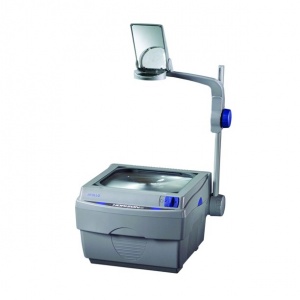Educational Technology
Educational technology or instructional technology (often referred to by shorthand as edtech) is the practice of facilitating learning using both hardware and software technologies.[1] The purpose of educational technology is to improve education through both teaching and learning. Edtech often also refers to the variety of companies that design technology for education.

Educational technology has been shown to foster creativity, boost motivation, and increase engagement in classrooms.[3]
Contents
History
In the mid 1900s, audiovisual experts sought to build their industry by focusing on a new concept, educational technology. They wanted to make educational technology distinguishable from traditional classroom teachers. Educational technology has been formally defined many times.[4] One of the early definitions, in 1963, recognizes the “increasing awareness of the need for greater support of, and improvement in, American education” and a need for clarification of the emerging instructional technology.[5]
- 1963 Definition: “Audiovisual communications is that branch of educational theory and practice concerned with the design and use of messages which control the learning process. It undertakes: (a) the study of the unique and relative strengths and weaknesses of both pictorial and nonrepresentational messages which may be employed in the learning process for any reason; and (b) the structuring and systematizing of messages by men and instruments in an educational environment. These undertakings include planning, production, selection, management, and utilization of both components and entire instructional systems. Its practical goal is the efficient utilization of every method and medium of communication which can contribute to developing the full potential of the learner.”[6]
- 1977 Definition: "“Educational technology is a complex, integrated process involving people, procedures, ideas, devices, and organization, for analyzing problems and devising, implementing, evaluating, and managing solutions to those problems, involved in all aspects of human learning.”[7]
- 1994 Definition:“Instructional technology is the theory and practice of design, development, utilization, management and evaluation of processes and resources for learning”[8]

Classroom educational technology has evolved a lot over time. In the 1870s, classrooms started to use primitive versions of the slide projector; use of chalkboards and pencils began at the end of the 19th century.[10] Radios became popular in 1920s classrooms and the overhead projector followed a decade later.
Photocopiers were introduced in 1959 and quickly became a standard practice for the quick reproduction of materials. Calculators and Scantron testing were introduced in 1972 and eventually became standard practice.[11] The first everyday-use computers were introduced in the 1980s and by 2009, 97% of classrooms had one or more computers. The education world knew when computers were released that something great was occurring with immediate learning capabilities.[12]
Technologies
Edtech can be used in a variety of different ways to improve the overall educational experience. This includes hardware and software systems.
Hardware
There is a wide variety of hardware technology used in classrooms. School districts use cameras, computers, printers, projectors, tablets, Smartboards and more.
Software
Google Classroom
Clever
ClassDojo
Ethical Concerns
Educational technology often faces many barriers when schools try to implement it. There are cost barriers, resistance from teachers, and pushback from parents. There are also many ethical concerns that involve educational technology.[13]
Privacy
Google Chromebooks make up 60% of all laptops sold to K-12 schools, and the Google suite - including Google Classroom – are widely used across the nation in classrooms.[14] However, Google has admitted to scanning data and emails of students using the Google education systems in the classroom. Google faced a lawsuit for this in 2014 over concerns of US child-protection laws and potential violation of FERPA, the Family Educational Rights and Privacy Act.[15]
Paragraph 2
Accessibility
According to Barrier Break, a Digital Accessibility Testing agency, many educational technology tools lack adequate accessibility functionalities.[16] Students with cognitive, visual, auditory, neurological and physical disabilities often face issues with edtech. The disadvantages thousands of students. Edtech tools often are not compliant with the American with Disabilities Act (ADA) nor with the Web Content Accessibility Guidelines (WCAG).[17] This issue was heightened by the Covid-19 pandemic with over a billion students shifting to remote learning, where students with disabilities faced hurdles with edtech.
Access
There are significant disparities in the access that students have to technology between affluent and lower income schools. A report shows that 52% of teachers in affluent school districts feel their students have technology necessary to complete homework, while only 3% of teachers in high-poverty districts felt that way.[18]
See Also
References
- ↑ Januszewski, Alan, and Michael Molenda. Educational Technology: A Definition with Commentary. Lawrence Erlbaum Associates, 2008, Google Books, https://books.google.com/books?hl=en&lr=&id=JO3Yc0UuK74C&oi=fnd&pg=PP2&dq=educational+technology&ots=aBz1U2gMPs&sig=JBqrsEGgT_LimbeMenrm7n_luh0#v=onepage&q&f=false, Accessed 26 Jan. 2022.
- ↑ “Technology Can Close Achievement Gaps, Improve Learning.” Stanford Graduate School of Education, Stanford University, 19 Sept. 2014, https://ed.stanford.edu/news/technology-can-close-achievement-gaps-and-improve-learning-outcomes.
- ↑ Kurt, Serhat. “Planning for Educational Technology Integration.” Educational Technology, 19 Sept. 2017, https://educationaltechnology.net/planning-educational-technology-integration/.
- ↑ Januszewski, Alan. Educational Technology: The Development of a Concept. Libraries Unlimited, 2001, Google Books, https://books.google.com/books?id=mlZsIIoOaSYC&printsec=frontcover#v=onepage&q&f=false, Accessed 27 Jan. 2022.
- ↑ Ely, Donald P. “The Changing Role of the Audiovisual Process in Education--a Definition and a Glossary of Related Terms.” ERIC, Institution of Education Sciences, 30 Nov. 1962, https://eric.ed.gov/?id=ED016409.
- ↑ Ely, Donald P. “The Changing Role of the Audiovisual Process in Education--a Definition and a Glossary of Related Terms.” ERIC, Institution of Education Sciences, 30 Nov. 1962, https://eric.ed.gov/?id=ED016409.
- ↑ AECT task force on definition and terminology. “The Definition of Educational Technology. .” ERIC, Association for Educational Communications and Technology, 30 Nov. 1976, https://eric.ed.gov/?id=ED192759.
- ↑ Seels, B. B., & Richey, R. C. (1994). Instructional technology: The definition and domains of the field. Washington, DC: Association for Educational Communications and Technology.
- ↑ “Apollo Audio Visual Model 16000 Overhead Projector, 2000 Lumens, 14 1/2 x 15 x 27.” Walmart.com, https://www.walmart.com/ip/APOLLO-Audio-Visual-Model-16000-Overhead-Projector-2000-Lumens-14-1-2-X-15-X-27/14930027.
- ↑ “The Evolution of Technology in the Classroom.” Purdue University Online, https://online.purdue.edu/blog/education/evolution-technology-classroom.
- ↑ “The Evolution of Technology in the Classroom.” Purdue University Online, https://online.purdue.edu/blog/education/evolution-technology-classroom.
- ↑ “The Evolution of Technology in the Classroom.” Purdue University Online, https://online.purdue.edu/blog/education/evolution-technology-classroom.
- ↑ Kurt, Serhat. “Planning for Educational Technology Integration.” Educational Technology, 19 Sept. 2017, https://educationaltechnology.net/planning-educational-technology-integration/.
- ↑ Watters, Audrey. “The 100 Worst Ed-Tech Debacles of the Decade.” Hack Education, 31 Dec. 2019, http://hackeducation.com/2019/12/31/what-a-shitshow.
- ↑ “Google Faces Lawsuit over Email Scanning and Student Data.” The Guardian, Guardian News and Media, 19 Mar. 2014, https://www.theguardian.com/technology/2014/mar/19/google-lawsuit-email-scanning-student-data-apps-education.
- ↑ “EdTech Digital Accessibility.” BarrierBreak, 7 July 2021, https://www.barrierbreak.com/edtech-digital-accessibility/.
- ↑ “EdTech Digital Accessibility.” BarrierBreak, 7 July 2021, https://www.barrierbreak.com/edtech-digital-accessibility/.
- ↑ “Technology Can Close Achievement Gaps, Improve Learning.” Stanford Graduate School of Education, Stanford University, 19 Sept. 2014, https://ed.stanford.edu/news/technology-can-close-achievement-gaps-and-improve-learning-outcomes.